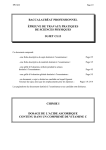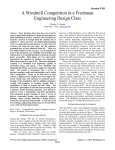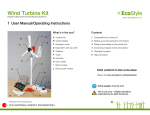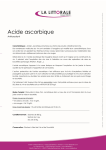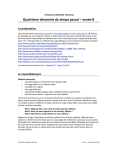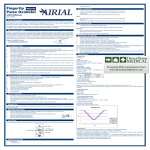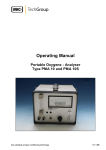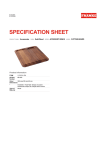Download Molecules & Fuel Cell Technology
Transcript
TEAK Molecules & Fuel Cell Technology Lesson Plan Page 1 Molecules & Fuel Cell Technology Overview This kit contains activities for the students to gain a better understanding about chemical energy and its use in creating electrical energy. Basic concepts of chemical energy including chemical bonds and chemical reactions will be presented. Students will model and observe electrolysis. They will be exposed to current research into alternative fuel sources, mainly hydrogen and the use of fuel cells. Additional Materials Required Distilled water Paper towels AA Batteries Small Screw Driver Syringe with small tube (coffee stirrer) Bowl (if there is no sink available) Learning Outcomes How to Recognize a Chemical Reaction Chemical Bonds and Molecular Structures How Energy can be Transformed Engineering Connection Certain types of engineers work on the molecular level to improve and study structures. They know how molecules are bonded together can determine the physical and structural properties of substances. They are also working on ways to harness the power of chemical reactions to produce new alternative fuel sources. Activity Descriptions Molecule Building Activity – 15 minutes Using standard molecule building ball and stick models, the students will be guided through an activity allowing them to put together a few common molecules and then extend this knowledge to a basic understanding of hydrocarbon fuels and electrolysis. Fuel Cell Car – 30 minutes This fuel cell car kit allows students to see a real fuel cell in action that is powering a small car around the room. Students will be able to observe electrolysis and interact with an operating fuel cell. Partial support for the TEAK Project was provided by the National Science Foundation's Course, Curriculum, and Laboratory Improvement (CCLI) program under Award No. 0737462. Any opinions, findings, and conclusions or recommendations expressed in this material are those of the author(s) and do not necessarily reflect the views of the National Science Foundation. TEAK Molecules & Fuel Cell Technology Lesson Plan Page 2 Resources NMSEA Curriculum Listing http://www.nmsea.org/Curriculum/Listing.htm From Oil Wells to Solar Cells http://www.nmsea.org/Curriculum/Primer/from_oil_wells_to_solar_cells.htm Running Oil http://www2.nsta.org/energy/find/running/ Live Green Go Yellow http://www.gm/com/company/onlygm/livegreengoyellow/index.html Enviro Literacy Teacher’s References http://www.enviroliteracy.org/teachers-index.php Environmental Literacy Council http://www.enviroliteracy.org Timeline of Energy History http://www.eia.doe.gov/kids/history/timelines/index.html Renewable Energy Lesson Plans http://www.infinitepower.org/lessonplans/htm Energy Changes Makes Things Happen http://www.ftexploring.com EIA Energy Kid’s Page http://www.eia.doe.gov/kids/glossary/ Frequently-Asked Questions about fruit batteries http://www.bluffton.edu/~bergerd/chem/food_batteries.html MadSci Network http://www.madsci.org/experiments/archive/889917606.Ch.html Science with Dr. T. http://www.dmturner.org/Teacher/Library/5thText/ChemTOC.html Hydrogen: Tomorrow’s Energy Source General Motors. Hydrogen: Tomorrow's Energy Source. Brochure. Lifetime Learning Systems, Inc, 2005. Note: Many of these resources were used in assisting the creation of the following lessons plans and we would like to thank and reference them for their valuable instruction. TEAK Molecules & Fuel Cell Technology Lesson Plan Molecules and Fuel Cell Technology (Approximately 1 hour) Concepts covered: Chemical Reactions Chemical Bonds Alternative Fuel Fuel Cell Car Page 3 TEAK Molecules & Fuel Cell Technology Lesson Plan Page 4 Molecules: Group discussion (Pose the following questions to the group and let discussion flow naturally… try to give positive feedback to each child that contributes to the conversation) **Note to facilitator: start building fuel cell car while co facilitator leads first discussion and activity. If they have already done Chem. Reactions & Electricity, use this page as review. ** Can you help me think of some forms of energy? Kinetic Chemical Potential Mechanical Electrical Heat Electromagnetic Nuclear What happens to energy when we use it? Energy is neither created nor destroyed. The total amount of energy stays the same – it only changes from one form to another. Look around. Everything you see has something in common. What do you think it is? Everything is made up of atoms. Atoms are the smallest particle of matter. The subatomic particles atoms are made up of are just tiny pieces of energy. Do you know what is an electron is? It is the negatively charged subatomic particle of energy that is found in a cloud around the center of an atom. How do atoms combine? Atoms combine by sharing or lending electrons. This is called a chemical bond. What is Chemical Energy? It is the energy stored in the bonds of atoms and molecules. A chemical reaction takes place when these bonds are broken or formed which releases the stored energy. What are some ways you can tell a chemical reaction is occurring? Gives off heat (exothermic) A solid is produced Becomes colder (endothermic) There is a color change A gas is produced Light is produced Where is chemical energy found in your life? Batteries Gasoline Digestion Burning Rust TEAK Molecules & Fuel Cell Technology Lesson Plan Page 5 In order to get a sense of how big an atom is: how long do you think it would be if you lined up 50 million atoms in a single line? It would only be about 1 centimeter in length! What is it called when several different kinds of atoms are bonded together? A molecule For example, a water molecule is formed when one oxygen atom and two hydrogen atoms are bonded together. When energy is used to separate bonded elements or compounds it is called electrolysis. When a chemical charge is applied to water, the charge breaks the chemical bond between hydrogen and oxygen. TEAK Molecules & Fuel Cell Technology Lesson Plan Page 6 Molecule Exploration Activity Objectives Explore of the design of molecules based on electron bonding structures. Obtain an understanding of the basic form of substances in chemical energy. Obtain an understanding of the process by which molecules react. Materials 1 Molecule Kit per Group Procedure 1. 2. 3. 4. 5. Handout the Molecule Activity Worksheet. Using one of the Molecule Kits, demonstrate what the sheet means by showing them hydrogen. Emphasize a molecule is only stable when all the holes are filled. Handout a Molecule Kit for each group Allow student to experiment with the kits and build the molecules described on the worksheet. Expected Results The students should experiment with a variety of different molecules, combining smaller molecules to make larger more complex chains of hydrocarbons. They should model electrolysis so they have a better understanding of what they are going to see with the fuel cell car. This activity is meant to give them a deeper understanding of the structures that exist in their natural world. **Notes to facilitator: CHECK THE FLOOR FOR MOLECULE BALLS** End of Molecule Exploration Activity TEAK Molecules & Fuel Cell Technology Lesson Plan Page 7 Molecule Building Activity *** FOR A MOLECULE TO BE COMPLETE ALL THE HOLES OF AN ATOM MUST BE FILLED, OR ELSE THERE ARE “LOOSE” ELECTRONS AND THE MOLECULE IS UNSTABLE! *** O = Oxygen (Red) H = Hydrogen (White) C = Carbon (Black) N = Nitrogen (Orange) Build the following molecules: Molecule Chemical Formula Lewis Structure (each dash represents a bond) Hydrogen H2 H – H Carbon Dioxide CO2 O = C = O Water H2O O / H \ H Oxygen O2 O = O Nitrogen N2 N Ethanol C2H6O N H H | | H–C–C–O–H | | H H Electrolysis breaks molecules of H2O apart. When energy is applied to water, the water molecules break apart and form something else. Experiment and see what molecules (other than water) you can form from two H2O molecules. Hint: you should find that you can make two molecules from the chart above. The following molecules contain only hydrogen and carbon. They are called hydrocarbons. Common hydrocarbons include coal, petroleum, and natural gas which are better known as fossil fuels. Molecule Chemical Formula Methane (a natural gas) CH4 Propane (used as a fuel to cook with a grill) C3H8 Lewis Structure (each dash represents a bond) H | H - C - H | H H H H | | | H - C - C - C - H | | | H H H TEAK Molecules & Fuel Cell Technology Lesson Plan Page 8 Molecules: Concluding Discussion Electrolysis breaks molecules of water apart into hydrogen and oxygen gas. Why would you want to do this? You could then use the hydrogen and oxygen separately for other things. Do you think it is important how atoms are bonded together? It is important. For example, diamonds and graphite are both made of only carbon. The only difference is how they are bonded together! Diamonds are so strong they are used in machining things like metals, and you use graphite to write with! TEAK Molecules & Fuel Cell Technology Lesson Plan Page 9 Fuel Cell: Group Discussion Do you know the source of power in our cars today? Fuel or gasoline The common fuels we use are made from petroleum and can have several different forms besides just gasoline like diesel. Now, scientists are trying to develop cars that run on just liquid hydrogen. But why hydrogen? Hydrogen is the most plentiful gas in the universe and the most abundant element on earth. It is the simplest/lightest element It has the highest energy content of any known fuel. It cannot be found as a gas on earth – it can only be found when combined with other elements like water, sugar, ammonia and hydrogen peroxide. This means it must be extracted from other sources before it can be used which requires energy. Hydrogen is also cleaner than gasoline or diesel. What is a fuel cell? Have you ever heard of one? A fuel cell is similar to a battery. When hydrogen enters a fuel cell, it splits into protons and electrons. The protons are free to move however they want through the fuel cell and the electrons are forced to move through an external circuit. This movement of electrons is what causes electrical energy. The hydrogen protons and electrons combine with oxygen molecules and form water (H2O). So what is the difference between electrolysis and a fuel cell? Electrolysis spits water into hydrogen and oxygen Fuel cells combine hydrogen and oxygen into water. Ideally, you can use electrolysis and a fuel cell to continually split and form water over and over again which would mean a continuous amount of electricity. However, the technology isn’t perfect yet. TEAK Molecules & Fuel Cell Technology Lesson Plan Page 10 Fuel Cell Car Activity Objectives Understand electrolysis and see it occur Understand how gases can be created from the splitting of water Show that energy can be created safely and in an environmentally sound way through alternative chemical sources. Group Materials: 1 Fuel Cell Car Kit Distilled Water Container Procedure: 1. Have each member in a team count off from 1 – 4. Be creative if there are more or less kids in a group. 2. Explain that they will be going through the activity as a whole class step-by-step and there will be a signal (clapping, raising hands, flashing the lights, etc) to alert them when we will go to the next step. 3. One facilitator will read off the steps on the following sheets. 4. Use different group kits as an example for steps if needed. *For a troubleshooting guide or more detailed instructions, see the User Manual* Expected Results The car should be able to drive the length of the room after hydrolysis. This will demonstrate to the students how power can be generated from an environmentally safe chemical reaction. Discuss how this is another method for producing electricity that should be considered in the future. End of Fuel Cell Car Activity TEAK Molecules & Fuel Cell Technology Lesson Plan Page 11 Working in teams is really important in engineering. Each member has their own critical part to do. 1. Industrial Engineer – IE – Your main task is to supervise each process and alert an instructor if there is a problem or if your team has questions. You are to make sure all the parts are handled carefully and correctly. 2. Mechanical Engineer – ME – Your main task is to assemble and disassemble the fuel cell car. While the car is running your job is to make sure it does not fall off a table, get stepped on, etc. 3. Electrical Engineer – EE – Your main task is to carefully connect wires. If something is not connected correctly, it will damage the fuel cell. Also, you need to make sure the metal ends of the battery pack to not touch when it is turned on. 4. Chemical Engineer – CE – Your main task is to help with any step that involves the water. You will be getting your fingers wet. Before we take out the kit, there are some things we need to go over. 1st, the parts are fragile so please be careful when handling them. We want other schools to be able to use them too. 2nd, we are going to go through these steps together so after each step IEs raise your hands so we know your team is ready to move on. Let’s get started! Assembling the Car IE – Open the kit. Take a note on how everything is put in the box because you will be responsible for putting the parts back. Take out the body, wheels, and cylinders. Give them to the ME. ME – Attach the wheels to the base (make sure you hear a click). Carefully push the cylinders in the round holes on the base. Place the fuel cell in the rectangular slot so the short tubes are coming off the top and the H2 and O2 sides match the H2 and O2 cylinders. CE – Make sure the small slots in the bottom of the storage tanks car are not blocked by anything. Then carefully fill the cylinders with distilled water until the top of the inner cylinder is underwater. The inner cylinders should fill up with water. Next, connect the long tubes coming from the fuel cell to the correct storage tanks. *Facilitators – go around to each group and push water ONLY through the O2 side. Make sure that the fuel cell car is set up correctly and the storage tanks are not blocked.* Electrolysis EE – take out the battery pack but don’t turn it on. This next step is important, if done wrong the fuel cell will be damaged and your car will not work. Plug the black end of the battery to the black (H2) side of the fuel cell and the red end of the battery pack to the red (O2) side of the fuel cell. Make sure everyone can see the storage tanks and then turn on the battery pack. You should see gasses filling up the storage tanks. The O2 side is collecting oxygen gas and the H2 side is collecting hydrogen gas. This is the process of electrolysis – splitting water into hydrogen and oxygen. TEAK Molecules & Fuel Cell Technology Lesson Plan Page 12 Starting the Car IE – when the hydrogen storage tank is at least half full, turn off the battery pack and disconnect it from the fuel cell. ME – carefully pick up the fuel cell car. (When the EE connects the motor wires the car will automatically start). EE – Connect the red wire coming from the motor to the red (O2) side of the fuel cell and the black wire to the black (H2) side of the fuel cell. The second wire you plug in will start the fuel cell. ME – put the car down and watch it go! Clean-up CE – Disconnect the fuel cell from the motor. Pull out the storage tanks and disconnect them from the fuel cell. Carefully take off the cylinders and go dump them out. EE – Dry anything that needs it (the storage tanks, the cylinders, the floor, etc.) ME – Finish disassembling the car and help dry anything that needs it. IE – Put the parts back into the box like you found them. TEAK Molecules & Fuel Cell Technology Lesson Plan Page 13 Fuel Cell: Concluding Discussion What are some advantages of fuel cell cars? The only by-products are pure water and heat. No combustion Reliable Efficient Operates cleanly – environmentally friendly Quiet No pollution What do you think are some disadvantages to this fuel cell car? Hydrogen and Oxygen need to be split before the energy generation can start, so we need to find an economic and clean way to split H2O before we can really take advantage of fuel cell cars. TEAK Molecules & Fuel Cell Technology Lesson Plan Page 14 Further Exploration What is an ion? An ion is an atom or molecule that has lost or gained an electron – making it positively or negatively charged. More about electrolysis Positive hydrogen ions and negative ions are formed. An electrolyzer has 2 electrodes where ions form. The anode is negatively charged and attracts the negatively charged ions. The cathode is positively charged and attracts the positively charged hydrogen ions. TEAK Molecules & Fuel Cell Technology Lesson Plan Page 15 Molecule Activity Extension Have the students create different molecules. Molecule Chemical Formula Ethanol C2H6O Caffeine C8H12N4O3 Hydrogen Peroxide Structure H H | | H–C–C–O–H | | H H O CH3 || / CH3 C N \ / \ / \ N C CH | || // C C - N // \ / O CH3 H2O2 H–O–O–H Glucose C6H12O6 H–C=O | HO – C – H | H – C – OH | HO – C – H | HO – C – H | CH2OH Vanillin C8H8O3 Vitamin C C6H8O6 Diamond vs. Graphite (both are made of carbon, the structures are different). More Hydrocarbons Butane Octane C C4H10 C8H18 TEAK Molecules & Fuel Cell Technology Lesson Plan Page 16 Trouble-Shooting Guide Molecular Ball Building Problem: Balls do not stay attached to springs. Solution: Twist balls slightly when attaching to springs Problem: Students are having difficulty using two springs to double-bond two atoms. Solution: Try using longer springs. Fuel Cell Car Problem: Unable to perform electrolysis Solution: Ensure the rear tank is filled with distilled water and the hydrogen and oxygen tanks are submerged. Ensure only the oxygen side of fuel cell has been filled with distilled water. Ensure the red wire of the battery is connected to the red side of the fuel cell, and the black wire of the battery is connected to the black side of the fuel cell. Try replacing the batteries. Problem: Car will not run Solution: Ensure that the black wire from the motor is plugged into the black (hydrogen) side of the fuel cell, and the red wire from the motor is plugged into the red (oxygen) side of the fuel cell. Ensure that there are no wires obstructing the movement of the wheels. Ensure that there is a supply of hydrogen and oxygen. If there is not, perform electrolysis. Ensure the fuel cell is connected to the hydrogen and oxygen tanks properly.
















